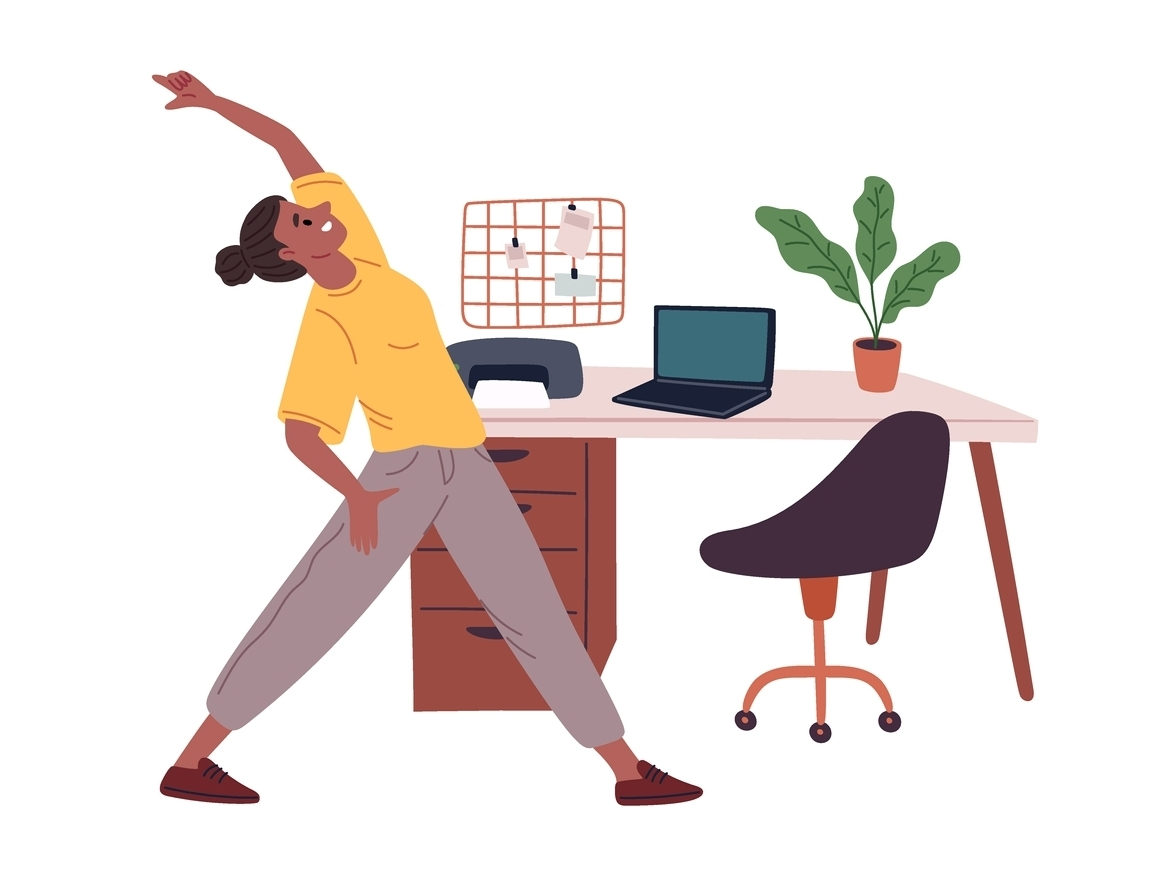The American Heart Association recommends that adults get at least 150 minutes of moderate-intensity or 75 minutes of vigorous physical activity each week.1 The Centers for Disease Control and Prevention (CDC) physician Activity Guidelines for Americans recommends that adults get at least 150-300 minutes of moderate-intensity or 75-150 minutes of vigorous-intensity aerobic physical activity a week.2 They further advise that adults should move more and sit less throughout the day, and that any amount of physical activity is better than none.
Achieving adequate levels of physical activity can be challenging, especially for those who work full time.3 The Bureau of Labor Statistics estimates that in 2024, 30.6% of US workers were sedentary at work, defined as a job where workers sit throughout the day and perform tasks that require only minimal physical effort, such as lifting lightweight objects.4 Another 33.3% of workers perform light work, defined as a job where more than 1/3 of their workday is spent standing and may have to carry light items like menus or pagers.
Additionally, extended periods of time spent sedentary has been associated with a wide range of negative health outcomes, including the development of type 2 diabetes, cardiovascular disease, and all-cause mortality.5 Maintaining adequate levels of physical activity can help to attenuate or even eliminate these risks.6 Because working hours present an opportunity to improve levels of physical activity, the CDC recommends that workplaces encourage employees to be physically active.2 Incorporating physical activity into the workday can help employees to achieve the recommended levels of physical activity.
Depending on the nature of the work, this may be more or less logistically feasible.7,8 Some potential strategies include active commuting (biking or walking to work rather than driving), preferentially taking the stairs, using a standing or walking desk, having walking meetings, using small hand-held exercise devices (weights, exercise bands, grip strengtheners) at a desk, and engaging in physical activity during breaks.
Incorporating stair use into daily routines can enhance physical activity and improve cardiovascular health. A 2010 observational study followed 77 employees who participated in a 12-week promotional campaign to increase stair use.9 Employees increased their median daily number of ascended and descended one-story staircase units from 4.5/day to 20.6/day, equating to about ten minutes of exercise integrated into their workday. At 12 weeks, average maximal aerobic capacity had improved by about one metabolic equivalent of task (MET) (p<0.001). There were statistically significant reductions in waist circumference (1.55 cm, p<0.001), weight (0.55 kg, p=0.022), and diastolic blood pressure (1.77 mmHg, p=0.028).
Using standing or walking desks in the workplace can also reduce sedentary behavior and promote physical activity. A 2015 systematic review found standing desks can increase energy expenditure by 4.1-20.4 kcal/hour while treadmill desks can boost energy expenditure by an average of 100.04 kcal/day.10
Incorporating physical activity into the work can not only help employees increase their level of physical activity, but it can also improve their work performance. A 2020 cross-sectional study from Tokyo (n=1,321) examined the effect of how often employees exercised at work on various health metrics, surveying multiple companies and employees in various desk jobs.11 Compared to those who exercised less than once per week at work, those who exercised three times per week or more had higher levels of physical activity (15.9 minutes more, p=0.001) and spent less time sitting each day (11.3 minutes less, p=0.066). They also had a higher level of work engagement as assessed by a modified version of the Utrecht Work Engagement Scale (UWES-9), with 62.1% of those exercising more often at work scoring high on the assessment compared to 44.1% of those exercising less often or not at all (p<0.001).
References
- Lloyd-Jones DM, Allen NB, Anderson CA, et al. Life’s essential 8: updating and enhancing the American Heart Association’s construct of cardiovascular health: a presidential advisory from the American Heart Association. Circulation. 2022;146(5):e18-e43.
- Piercy KL, Troiano RP, Ballard RM, et al. Physical Activity Guidelines for Americans, 2nd edition. Washington, DC: U.S. Department of Health and Human Services; 2018.
- de Souto Barreto P. Time to challenge public health guidelines on physical activity. Sports medicine. 2015;45:769-773.
- Occupational Requirements in the United States – 2024. November 19, 2024. https://www.bls.gov/news.release/ors.nr0.htm
- Biswas A, Oh PI, Faulkner GE, et al. Sedentary time and its association with risk for disease incidence, mortality, and hospitalization in adults: a systematic review and meta-analysis. Annals of internal medicine. Jan 20 2015;162(2):123-32. doi:10.7326/m14-1651
- Ekelund U, Steene-Johannessen J, Brown WJ, et al. Does physical activity attenuate, or even eliminate, the detrimental association of sitting time with mortality? A harmonised meta-analysis of data from more than 1 million men and women. Lancet (London, England). Sep 24 2016;388(10051):1302-10. doi:10.1016/s0140-6736(16)30370-1
- Ryde GC, Atkinson P, Stead M, Gorely T, Evans JMM. Physical activity in paid work time for desk-based employees: a qualitative study of employers’ and employees’ perspectives. BMC Public Health. 2020/04/06 2020;20(1):460. doi:10.1186/s12889-020-08580-1
- Zhang T, Ham J, Ren X. Why Exercise at Work: Development of the Office Exercise Behavior Determinants Scale. Int J Environ Res Public Health. Mar 8 2021;18(5)doi:10.3390/ijerph18052736
- Meyer P, Kayser B, Kossovsky MP, et al. Stairs instead of elevators at workplace: cardioprotective effects of a pragmatic intervention. European journal of cardiovascular prevention and rehabilitation. 2010;17(5):569-575. doi:10.1097/HJR.0b013e328338a4dd
- MacEwen BT, MacDonald DJ, Burr JF. A systematic review of standing and treadmill desks in the workplace. Preventive medicine. 2015;70:50-58.
- Jindo T, Kai Y, Kitano N, Tsunoda K, Nagamatsu T, Arao T. Relationship of workplace exercise with work engagement and psychological distress in employees: A cross-sectional study from the MYLS study. Prev Med Rep. Mar 2020;17:101030. doi:10.1016/j.pmedr.2019.101030

